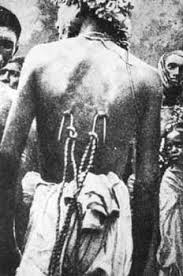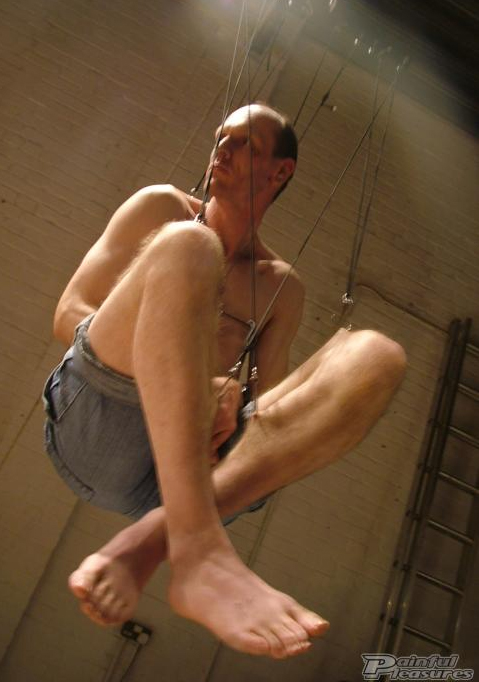 Human suspension is the act of suspending a person from large-gauge hooks that are carefully placed through temporary body piercings created immediately before the act of suspension. It’s a tradition that dates back thousands of years and that was historically strictly performed for sacred, ritualistic purposes.
Human suspension is the act of suspending a person from large-gauge hooks that are carefully placed through temporary body piercings created immediately before the act of suspension. It’s a tradition that dates back thousands of years and that was historically strictly performed for sacred, ritualistic purposes.
The Origin of Human Suspension
The oldest recorded acts of human suspension date back approximately 5,000 years and originated among devout Hindus in India. According to Skin-Artists.com, the practice began as Hindu spiritual leaders explored the connections of body and spirit, during a time when “…the idea of using the body to transcend the body played an important role in spirituality and life.” It was deemed by practitioners to be an act of penance that would prove one’s ever-growing devotion to the Hindu gods if they engaged in progressively more intense suspension sessions.
 While the practice may have been embraced by more Hindus earlier on, today human suspension is practiced almost exclusively by the Savite Hindus of India who worship the gods Siva, Murugan, and Kali. Although human suspension festivals are now banned in both India and Sri Lanka, the Tamil people of southern India still believe in the spiritual power of human suspension. Additionally, human suspension festivals now abound in other areas of Southeast Asia, such as Thailand and Malaysia.
While the practice may have been embraced by more Hindus earlier on, today human suspension is practiced almost exclusively by the Savite Hindus of India who worship the gods Siva, Murugan, and Kali. Although human suspension festivals are now banned in both India and Sri Lanka, the Tamil people of southern India still believe in the spiritual power of human suspension. Additionally, human suspension festivals now abound in other areas of Southeast Asia, such as Thailand and Malaysia.
Human Suspension Among American Indians
In addition to being practiced by devotees in Southeast Asia, human suspension has been a tradition among certain North American Indian tribes for centuries. Most notably, the Mandan Tribe who lived along the banks of the Missouri River and two of its tributaries , and who now reside in North Dakota, made human suspension a focal point during their annual Okipa (Oh-Kee-Pa) ceremonies. The Okipa ceremonies were first formally documented by George Catlin, a member of the Louis and Clark expeditions who described the ceremonies as 4-day-long events that required extensive preparation and self-sacrifice by all participants. During these ceremonies, Mandans training to become warriors would be strained to their breaking points and beyond in their efforts to work for their gods’ approval by not only being suspended for long periods of time, but also weighted down and burdened with other stressors that typically resulted in them losing consciousness.
, and who now reside in North Dakota, made human suspension a focal point during their annual Okipa (Oh-Kee-Pa) ceremonies. The Okipa ceremonies were first formally documented by George Catlin, a member of the Louis and Clark expeditions who described the ceremonies as 4-day-long events that required extensive preparation and self-sacrifice by all participants. During these ceremonies, Mandans training to become warriors would be strained to their breaking points and beyond in their efforts to work for their gods’ approval by not only being suspended for long periods of time, but also weighted down and burdened with other stressors that typically resulted in them losing consciousness.
Modern-Day Human Suspension
While extreme rites of passage have been a core element in tribal cultures around the world since the beginning of human history, it’s interesting that two cultures with such great distance between them both discovered the spirituality of human suspension seemingly independently of each other. It shows a commonality among humanity as a whole to go to whatever lengths necessary to obtain spiritual enlightenment and supplicate one’s higher power.  It’s no wonder that the tradition of human suspension has not only survived for thousands of years, but truly begun to flourish in modern-day society. In the western world, there are still many practitioners who believe in the process for the pure purpose of spiritual enlightenment, but thanks in large part to Allen Falkner, many have discovered the practice’s non-spiritual benefits, like relaxation, quieting the mind, developing physical endurance, and utilization as an engaging performance art medium.
It’s no wonder that the tradition of human suspension has not only survived for thousands of years, but truly begun to flourish in modern-day society. In the western world, there are still many practitioners who believe in the process for the pure purpose of spiritual enlightenment, but thanks in large part to Allen Falkner, many have discovered the practice’s non-spiritual benefits, like relaxation, quieting the mind, developing physical endurance, and utilization as an engaging performance art medium.
Allen Falkner also played a large role in the development of the different core human suspension positions and variations of them that are utilized today. The most common positions include:
- Chest Suspension – Suspension hooks are placed in the chest so that the body hangs vertically to the ground.
- Coma Suspension – The body is positioned face-up and horizontal to the ground by placing hooks through the chest, torso and legs. The name stems from the positioning of the body, which is not unlike a comatose person laying in a hospital bed.
- Suicide Suspension – Typically suspension hooks are placed only through the back of the torso so that the body hangs vertically to the ground. Being suspended in this position has a similar appearance to that of a person who has committed suicide by hanging, hence the name.
- Crucifix Suspension – The main difference between this position and the Suicide position is that hooks are placed through both the back of the torso and the arms, so that the body appears crucified when suspended.
- Superman Suspension – Rows of hooks placed along the back side of a person’s body give them the appearance of flying like Superman in this human suspension position.
- Faulkner or Knee Suspension – Hooks placed through the knees invert a suspendee’s body so that their head is closest to the ground. It was first performed by Allen Faulkner, which is why it’s known as the Faulkner position as well as knee suspension.
- Resurrection – In this position, the body is typically suspended by hooks placed through the belly, causing the body to hang in an arced way that causes it to look as if it’s being drawn up like a body resurrected from the grave.
 There’s a lot of preparation involved in suspending a human body in any position–work that often requires a group of skilled professionals experienced in the art of human suspension. Proportionate to the time that the average person stays suspended, it takes much longer to do the prep work of gathering suspension supplies, performing safety procedures such as proper skin prep, piercing the body, inserting suspension hooks, and setting up the rigging required to actually suspend someone. That said, it’s possible to stay suspended for hours once rigged up, if you have the experience and desire to do so.
There’s a lot of preparation involved in suspending a human body in any position–work that often requires a group of skilled professionals experienced in the art of human suspension. Proportionate to the time that the average person stays suspended, it takes much longer to do the prep work of gathering suspension supplies, performing safety procedures such as proper skin prep, piercing the body, inserting suspension hooks, and setting up the rigging required to actually suspend someone. That said, it’s possible to stay suspended for hours once rigged up, if you have the experience and desire to do so.
Many people say the act of being suspended makes them feel freer, more relaxed, more in touch with their bodies and spirits, and closer to their higher powers than anything else they’ve ever experienced. If you’re interested in exploring this time-honored tradition further, you can read more about it in our blog post, The Art of Human Suspension. You may also want to visit Suspension.org to learn about upcoming events in your area ranging from educational workshops to human suspension performances.
References
Body Suspension Article on Skin-Artists.com
The Art of Human Suspension Blog Post on PainfulPleasures.com
A Short History of Suspension Article on LifeSuspended.org
Suspension (body modification) Article on Wikipedia.org
Mandan Article on Wikipedia.org


Comments are closed here.